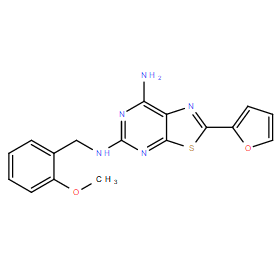| DC47767 |
N6-Benzyl-5'-ethylcarboxamido adenosine
|
N6-Benzyl-5'-ethylcarboxamido adenosine is a selective A3 adenosine receptor agonist. |
| DC47766 |
Adenosine receptor antagonist 1
|
Adenosine receptor antagonist 1 is a A2aR-selective antagonist with an IC50 of 0.29 nM and displays 14-fold more selective for A2aRthan A2bR. |
| DC47765 |
hA3AR agonist 1
|
hA3AR agonist 1 is a potent human A3 adenosine receptor (hA3AR) agonist with a Ki value of 2.40 nM. |
| DC47235 |
Binodenoson
|
Binodenoson (MRE-0470) is a potent and selective A2A adenosine receptor agonist (KD=270 nM). Binodenoson is being developed as a short-acting coronary vasodilator as an adjunct to radiotracers for use in myocardial stress imaging. |
| DC47196 |
UK-432097
|
UK-432097 is a highly potent and selective A2AAR agonist with a pKi of 8.4 for human A2AAR. UK-432097 has anti-inflammatory and anti-aggregatory properties. UK-432097 has the potential for COPD (Chronic Obstructive Pulmonary Disease) research. |
| DC47006 |
A2B receptor antagonist 2
|
A2B receptor antagonist 2 (compound 18) is an adenosine receptor A2B antagonist, with Ki values of 2.30 μM, 6.8 μM and 3.44 μM for rA1, rA2A and hA2B, respectively. |
| DC46391 |
PSB-10 hydrochloride
|
PSB-10 hydrochloride is a potent and selective antagonist of human adenosine A3 receptor (A3AR), with a Ki of 0.44 nM. PSB-10 hydrochloride shows more than 800-fold selectivity for hA3 over rA1, rA2A, hA1, hA2A and hA2B receptors (Ki=805, 6040, 1700, 2700, 30000 nM, respectively). PSB-10 hydrochloride produces thermal hyperalgesia in mice. |
| DC45783 |
Norisoboldine hydrochloride
|
Norisoboldine hydrochloride is an orally active natural aryl hydrocarbon receptor (AhR) agonist. Norisoboldine hydrochloride, as a major isoquinoline alkaloid present in Radix Linderae, can be used for the research of Rheumatoid arthritis and Ulcerative colitis. |
| DC45528 |
5'-N-Ethylcarboxamidoadenosine (NECA)
|
5'-N-Ethylcarboxamidoadenosine (NECA, 5'-(N-Ethylcarboxamido)adenosine, Adenosine-5'N-ethylcarboxamide, 5'-Ethylcarboxamidoadenosine) is a stable, nonselective adenosine receptor agonist. 5'-N-Ethylcarboxamidoadenosine acts via multiple mechanisms including: reducing diabetes-induced oxidative stress, inhibiting gene expression of IL-18, TNF-α and ICAM-1 (intercellular adhesion molecule 1 (CD54)), and blocking activation of the JNK-MAPK pathway. |
| DC45384 |
LUF6096
|
LUF6096, a potent allosteric enhancer of the adenosine A3 receptor, is able to allosterically enhance agonist binding. LUF6096 shows low orthosteric affinity for any of the adenosine receptors. LUF6096 shows protective effects in myocardial ischemia/reperfusion injury. |






















